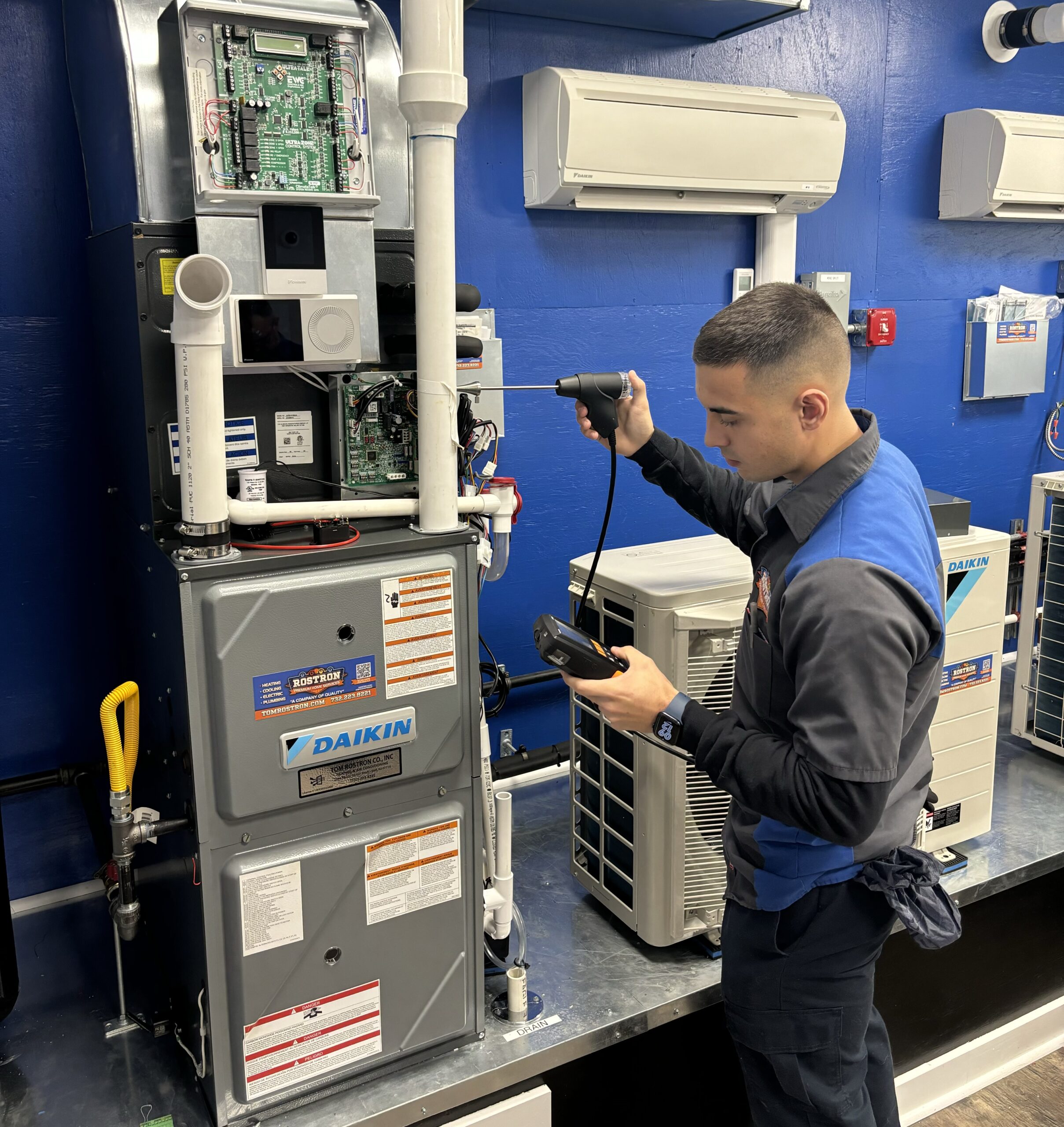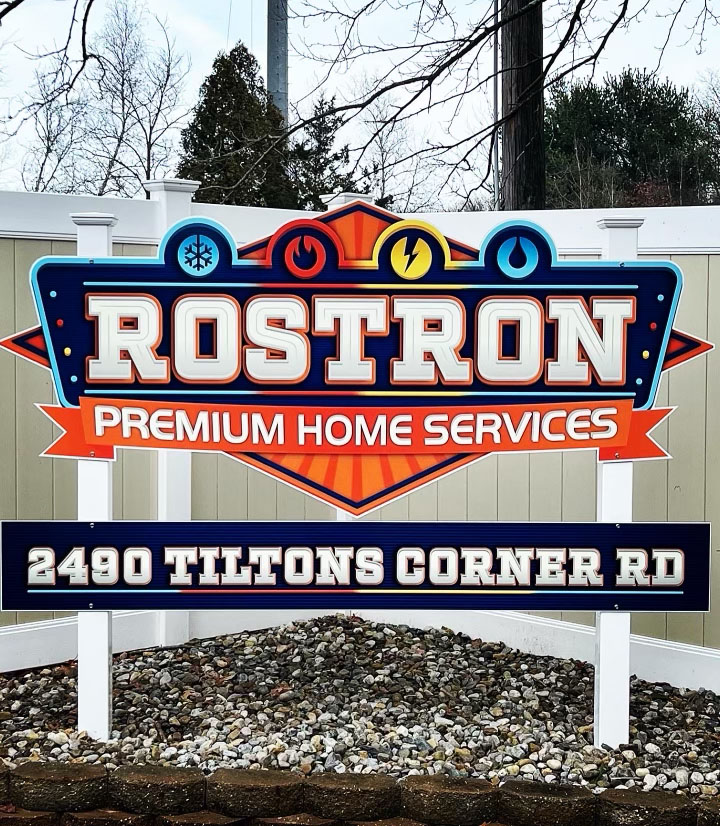Combustion analysis is the act of testing the combustion process of your furnace or boiler. The technicians at Rostron Premium Home Services complete this task by sampling the gasses in the flue piping with a tool called a combustion analyzer. This is one of many reasons why PREMIUM is in our name. Testing is sometimes performed during the installation and commissioning of new equipment and systems. However, combustion analysis should always continue to be performed on a periodic basis, like during a boiler or furnace maintenance. This is especially the case when a component impacting the combustion process has been repaired or replaced. Moreover, it is important to remember that consistent normal readings are more meaningful than an isolated normal reading.
All technicians at Rostron Premium Home Services have combustion analyzers on their trucks and use them for member & nonmember appointments. Each analyzer costs around $2,000.
For combustion to take place, 3 things are required: heat, oxygen, and fuel. These elements cannot be arbitrarily mixed. For combustion to be safe and efficient, there must be a proper amount and combination of each introduced to the burner. A burner and flue system must be calibrated to combine the proper quantities of each element for the proper mixture.

Here’s 5 reasons why combustion analysis is important for homeowners:
#5. Safety:
The safety of a boiler or furnace can be checked by performing a combustion analysis. Several aspects of the combustion can be checked. For example, draft readings can tell you if there is proper draft to carry the combustion gasses out of the house. Readings can be taken over the fire and in the stack to determine whether an obstruction exists. In addition, a stack temperature reading can let you know if the flue is running too hot. Both readings can be informative on whether unsafe gasses are entering the house when improper combustion is producing elevated levels of carbon monoxide (CO).
#4. Efficiency & Comfort:
Optimal efficiency and comfort is achieved when the proper amounts of fuel and oxygen are combined at the burner and the flue is operating normal. Your furnace or boiler is not efficient if it is burning too much fuel or is taking in more air than is recommended or required. Likewise, it is inefficient if less than required amounts of fuel or air are being delivered. An improper mixture of elements will cause improper readings.
Combustion readings will provide information on the levels of the byproduct gasses and thereby allowing for adjustments to the amount of fuel and air. Adjustments may be more difficult depending on the type of system you have. It’s also important to remember that making one adjustment may cause having to make further adjustments on other components on the system.
Knowing the impact each adjustment will have on other readings and what low and high level combustion readings mean, make combustion adjustments easier. A Rostron Premium Home Services technician will have a good sense of what adjustments are required when certain readings are not within normal range.
#3. Minimizing pollution:
In jurisdictions that regulate pollution levels from combustion, levels of byproduct gasses are measured to comply with local code. Analyzers measure the level of Nitrogen Oxides NOX and Sulfur Oxides SO2 that exist in the flue gas.
Technology exists that reduces the amount of these pollutant byproduct gasses. Manufacturers have certain models and options that reduce the amount of excess air or flame intensity thereby reducing the amount of these gasses being produced and expelled into the ozone. The downside to taking measures to reducing these pollutant gasses is that increased levels of carbon monoxide can occur at least when reduction of intake air is the method being utilized.
#2. Adhering to manufacturer’s specifications:
There are known “typical” combustion readings that are published and act as good guidelines. These typical readings are given for the type of fuel, equipment, and flue being used. In most cases, these guidelines should be followed. If confusing, let the technicians at Rostron Premium Home Services answer your questions.
#1. Improving longevity:
A combustion reading can tip you off on whether conditions exist that can have an impact on the longevity of your heating system. There are several conditions that can cause harm. Some conditions, if allowed to go unchecked for too long, can cause early failure.
One catastrophic failure is when the heat exchanger in a furnace develops cracks and leaks. When this happens, the heat exchanger or furnace itself must be replaced for safety reasons. A cracked heat exchanger can either cause carbon monoxide to enter the home or a flame rollout condition due to a pressurized combustion area. In either case, the conditions are not safe for occupants and the structure. A combustion analysis could have recorded readings indicating conditions that caused this failure. (eg. – bad draft, high draft temperatures). A crack could be shown by increased levels of O2.
A combustion analysis can also tip you off that equipment is creating excessive soot or that the system may have soot buildup that needs cleaning. (Soot: a black powdery or flaky substance consisting largely of amorphous carbon, produced by the incomplete burning of organic matter.) Excessive soot on the heat exchanger can hold moisture and start developing pitting compromising the metal.
An analysis can also indicate a lack of dilution air which means the system has been operating and creating condensation in the flue pathways. This can lead to short lived flues and flue liners from corrosion and deterioration.
For more information, here’s Evan S, an experienced Rostron Premium Home Service technician:



